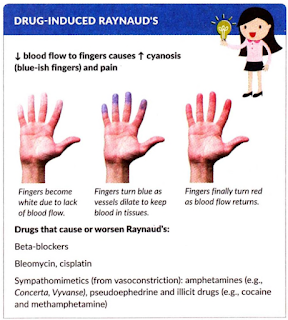Raynaud Phenomenon
Introduction
Raynaud phenomenon is a common condition that is triggered by exposure to cold and/or stress, leading to vasospasm in the extremities (most commonly in the fingers and/or toes).
- The vasospasm causes the skin to turn white and then blue, which is followed by painful swelling when the affected areas warm and can result in amputation in severe cases.
NOTE: Raynaud phenomenon can be a primary condition or can occur secondary to a connective tissue disease (e.g. systemic sclerosis) or other disease (e.g. arthrosclerosis, malignancy)
Management
For patients with uncomplicated Raynaud phenomenon (no progression to digital ulceration or critical ischemia), lifestyle changes are effective to control attacks.
- Avoid cold exposure, e.g. the use of gloves and warm clothing
- Smoking cessation
- Avoid vasoconstricting drugs, e.g. pseudoephedrine, phenylephrine, methylphenidate, beta blockers
In more severely affected patients, particularly those with an underlying connective tissue disease, vasodilators drugs may be used to reduce vasospasm.
- For first line therapy, use a dihydropyridine calcium channel blocker (e.g. nifedipine)
- Second-line therapy includes
- Intravenous prostanoids, e.g. iloprost
- Phosphodiesterase-5 inhibitor, e.g. sildenafil
- Topical glyceryl trinitrate (transdermal patches or ointment)
- Angiotensin II receptor blockers, e.g. losartan
- Alpha blockers, e.g. prazosin
- Selective serotonin reuptake inhibitors (SSRIs), e.g. fluoxetine

Comments
Post a Comment